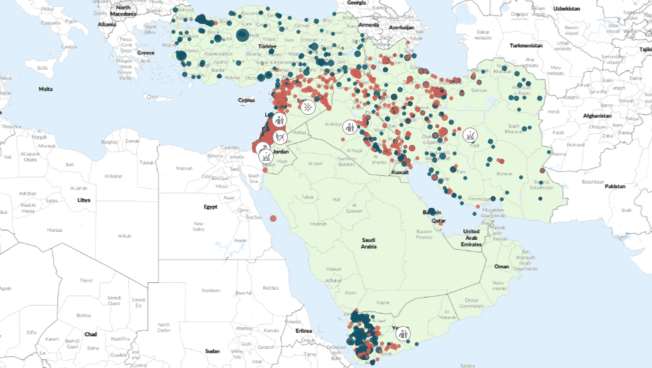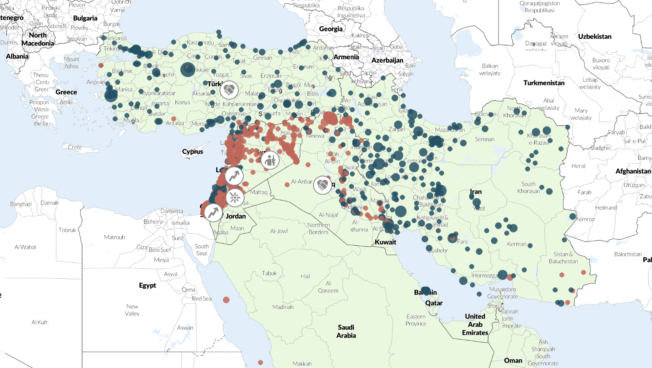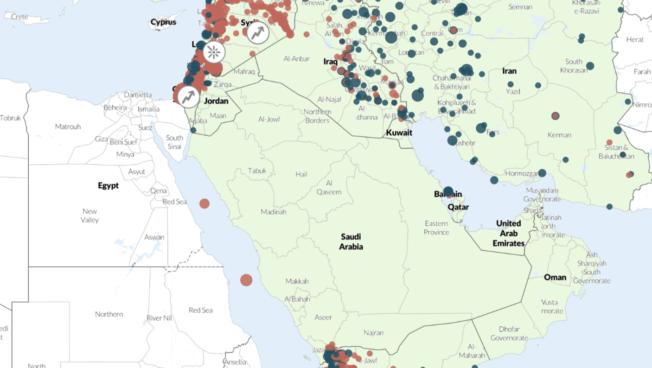Regional Overview
Middle East
April 2024
Posted: 10 May 2024
 Bahrain: Demonstrations surge in Bahrain despite royal pardon
Bahrain: Demonstrations surge in Bahrain despite royal pardon
Bahrain saw a significant surge in demonstrations in April, with double the number compared to March. This wave of protests is part of a larger upward trend that began in February with the commemoration of the 13th anniversary of the 2011 uprising in Bahrain. Protesters took to the streets denouncing the regime’s abuses against political prisoners and demanding their release. Demonstrations continued and even increased despite the Khalifa regime issuing a royal decree pardoning a total of 1,584 prisoners on 8 April, just a few days before Eid al-Fitr. Local media described the initiative as the largest royal pardon in Bahrain since the emir’s general amnesty in 2001,1Bahrain Mirror, ‘Recent Releases in Bahrain: Something Has Changed,’ 20 April 2024 and the government highlighted that 65% of the released prisoners were detained on rioting-related charges.2Yousef Saba, ‘Bahrain releases 1,584 prisoners after pardon,’ Reuters, 8 April 2024 Arguably, the decree aimed at reducing mounting domestic tensions and addressing international concerns over human rights. Following the pardon, demonstrations reached a weekly record high since August 2023, when protesters took to the streets in solidarity with political prisoners conducting a hunger strike. Demonstrations in Bahrain are becoming bolder, with a sizable number taking place in front of police stations in a direct challenge to state authority. An estimated 556 political prisoners remain in detention.3Al Wefaq National Islamic Society, ‘Al Wefaq: 556 political prisoners are still languishing in Bahrain’s prisons,’ 15 April 2024
 Iraq: Increased PKK activity in northern Iraq despite drop in Turkish strikes
Iraq: Increased PKK activity in northern Iraq despite drop in Turkish strikes
On 22 April, Turkey’s President Recep Tayyip Erdoğan visited Baghdad, marking his first state visit to Iraq since 2011.4Timour Azhari, Ece Toksabay, and Ahmed Rasheed, ‘Iraq, Turkey to elevate security, economic ties after Erdogan visit,’ Reuters, 22 April 2024 Bilateral talks resulted in agreements over water, trade, and security, with a strong emphasis on enhanced cooperation in countering the Kurdistan Workers Party (PKK) in northern Iraq, including the establishment of a joint military operations center.
An intense air campaign against the PKK preceded Erdoğan’s visit, coinciding with Turkish Foreign Minister Hakan Fidan’s visit to Baghdad and the decision of the Iraqi government to ban the PKK. During the visit, Turkey announced plans to conduct a comprehensive military operation against the PKK in Iraq and Syria in the summer.5Qassim Abdul-Zahra and Susan Fraser, ‘Kurdish separatists and water issues loom large in long-awaited visit of Turkey’s Erdogan to Iraq,’ Associated Press, 22 April 2024 While the aerial operations decreased in April, armed clashes between the PKK and Turkish forces in northern Iraq more than doubled compared to March, driven by PKK attacks on Turkish soldiers. The attacks, mainly concentrated in Duhok, intensified on the eve of Erdoğan’s visit, arguably in opposition to the bilateral talks.
 Iran-Israel: Regional tensions escalate after unprecedented direct Iranian attack against Israel
Iran-Israel: Regional tensions escalate after unprecedented direct Iranian attack against Israel
Overnight from 13 to 14 April, regional tensions peaked as Iran launched over 300 missiles and drones toward Israel, with some launched from Syrian, Iraqi, and Yemeni territory.6Israeli authorities estimated that of the 300 projectiles 170 were drones, more than 30 were cruise missiles, and more than 120 were ballistic missiles. Haaretz, ‘300 Drones and Missiles: How Iran’s First Direct Attack on Israel Began,’ 14 April 2024 Most of these were intercepted by Israeli and allied forces — including American, British, French, and Jordanian forces — before reaching Israeli territory. Debris from the missiles injured an Israeli Arab girl and resulted in minor material damages at various locations, including Nevatim airbase in southern Israel.7Jon Gambrell, ‘Satellite image analyzed by AP shows damage after Iranian attack on Israeli desert air base,’ Associated Press, 20 April 2024
Tehran’s retaliatory attack followed a series of Israeli strikes targeting top Islamic Revolutionary Guard Corps (IRGC) leaders in Syria beginning in December 2023. These operations culminated on 1 April, when an Israeli airstrike hit the Iranian embassy in Damascus, marking a shift in Israel’s rules of engagement.8Amwaj, ‘Inside story: Iran declares ‘new equation’ as all eyes on Israel’s next move,’ 14 April 2024 The strike killed seven IRGC members, including Mohammad Reza Zahedi, head of the Quds Forces in Syria and Lebanon. Zahedi is the highest-ranking Iranian officer killed since the US assassination of Qasem Soleimani in Baghdad in 2020.
After the 14 April attack, Iran cited the right to self-defense and declared the issue resolved.9X@Iran_UN, 14 April 2024 However, Israel responded on 19 April with a minor airstrike that damaged a military base in Isfahan but caused no casualties. Immediate fears of direct conflict between Israel and Iran subsided after Iran indicated that it would not retaliate for the Isfahan attack. This tit-for-tat escalation between Israel and Iran is the latest and most serious spillover of the current conflict that began after Hamas carried out a deadly offensive in southern Israel on 7 October 2023. Yet, despite the significant symbolic impact of the 13 April attack, confrontations between Israel and the ‘axis of resistance’ in the region decreased by 14% in April compared to the month prior.
 Palestine: Israel pulls troops from Gaza ahead of Rafah operation, while settler violence turns deadly in the West Bank
Palestine: Israel pulls troops from Gaza ahead of Rafah operation, while settler violence turns deadly in the West Bank
Last month, the number of violent events continued to decrease in the Gaza Strip as Israel prepared for an invasion of Hamas’ last stronghold in Rafah. On 1 April, the Israel Defense Forces (IDF) withdrew from al-Shifa hospital in Gaza City, after an operation targeting Hamas militants that began on 18 March. Later, on 17 April, the IDF also withdrew from the al-Nusayrat camp area after a 10-day operation. This resulted in a 38% decrease in armed clashes between the IDF and Palestinian militants and a 12% decrease in IDF airstrike events in April compared to the month prior.
In the diplomatic arena, no significant breakthrough occurred throughout the month. American-Egyptian-Qatari efforts to secure a ceasefire agreement continued, while Hamas rebuffed Israel’s proposal in mid-April. Negotiations resumed later in the month despite Israeli Prime Minister Benjamin Netanyahu’s vow to carry out the Rafah operation “with or without”10Al Jazeera, ‘Netanyahu says Israel will invade Rafah as Gaza ceasefire talks continue,’ 30 April 2024 a ceasefire. Meanwhile, under international pressure, Israel reopened the Erez crossing on 30 April to facilitate aid delivery into northern Gaza.11Associated Press, ‘The Latest | In Israel, Blinken pushes Hamas to agree on Gaza cease-fire deal,’ 1 May 2024
In the West Bank, armed Israeli settlers killed four Palestinians in separate raids, the first fatalities caused by settler violence since a series of deadly attacks in October 2023. Clashes persisted between Israeli forces and Palestinian factions, notably in Balata and Nur Shams refugee camps and Tulkarm city. Additionally, two new armed Palestinian groups emerged, including a suicide attack unit within the Tulkarm Youth of Revenge and Liberation.
 Syria: Demonstrations against HTS continue amidst rising tensions
Syria: Demonstrations against HTS continue amidst rising tensions
In April, tensions remained high in northwestern Syria, as Hayat Tahrir al-Sham (HTS) continued its campaign to crack down on alleged collaborators with the Syrian regime and foreign entities. Civilian targeting increased to five events in April from one the month prior, as HTS executed nine inmates, marking the highest reported fatality count since April 2020. Moreover, in a major development, the co-founder of HTS, Maysar al-Juburi, popularly known as Abu Maria al-Qahtani, was killed on 4 April by a booby-trapped box that detonated upon opening in the town of Sarmada in northern Idlib. Al-Qahtani was killed less than a month after his release from an HTS prison, where he had been detained since August 2023 on charges of alleged treason after communicating with the Global Coalition without coordinating with the group’s leadership.12Mohammed Hassan, ‘The long rise and sudden death of jihadist leader Abu Maria Al-Qahtani,’ Middle East Institute, 9 April 2024 Meanwhile, protests against HTS continued for the second consecutive month and intensified, with 82 demonstrations in 31 locations across Idlib and Aleppo provinces. Protesters demanded the immediate removal of HTS leader Abu Muhammad al-Julani and the dismantling of the group’s security apparatus.
 Yemen: Houthi forces expand maritime attacks to the Indian Ocean
Yemen: Houthi forces expand maritime attacks to the Indian Ocean
Overnight from 26 to 27 April, Houthi forces conducted their first confirmed attack in the Indian Ocean. The attack targeted the MSC Orion container ship, around 300 to 400 nautical miles southeast of the Horn of Africa, and was conducted with at least one drone, resulting in debris landing on the ship. Other attacks claimed by the Houthis earlier in the month, allegedly targeting the MSC Grace F and the MSC Veracruz in the Indian Ocean, were not confirmed. The Houthi leadership vowed to escalate attacks into the Indian Ocean in mid-March, a pledge reiterated on 25 April with a commitment to intensifying operations in this new conflict theater.13Yemen News Agency (SABA), ‘Text of the Revolutionary Leader’s speech on the latest developments in Palestine and regional developments,’ 25 April 2024 This geographical expansion of Houthi operations coincides with the lowest number of Houthi missile and drone attacks since they started targeting vessels in the Red Sea. Indeed, not a single attack was claimed from 10 to 24 April, marking the longest lull since December 2023. The lull followed the departure of the Behshad Iranian ‘spy’ ship from the region on 4 April. The ship was believed to be assisting Houthi forces in target acquisition.14Patrick Sykes, ‘Iran Ship Linked to Houthi Attacks Goes Home Amid Tensions,’ Bloomberg, 18 April 2024
For more, see the Red Sea attacks interactive map as part of the Yemen Conflict Observatory.
See More
See the Codebook and the User Guide for an overview of ACLED’s core methodology. For additional documentation, check the Resource Library. Region-specific methodology briefs can be accessed below.
Links:







